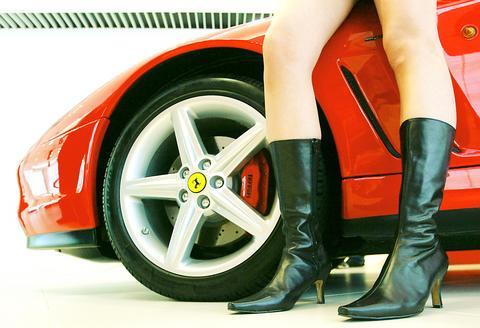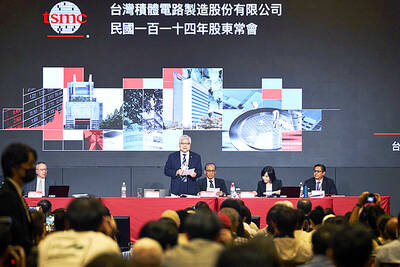Dozens of Ferraris cruised through Shanghai yesterday as the Italian sports car maker opened its first showroom in China, joining a wave of foreign luxury brands targeting newly rich Chinese buyers.
The company said it hopes to double sales in China this year of its Ferrari and Maserati brands to 200 cars -- priced at up to 3 million yuan (US$360,000) -- and plans to open dealerships in 11 mainland cities over the next 18 months.

PHOTO: REUTERS
"China is the future of Asia," said Richard Lee, chairman of the company's Chinese joint venture.
Western makers of high-priced cars, designer clothes and other luxury goods are pouring into China as a tiny but wealthy elite emerges, enriched by two decades of economic reform and foreign investment.
Italian designer Giorgio Armani opened a Chinese flagship boutique last month in Shanghai, the country's business capital and richest city.
The opening of Ferrari's marble-lined showroom in a luxury hotel lobby began with 60 of its low-slung sports cars parading through the city. They were driven by owners who brought them from as far away as Singapore and Hong Kong.
The event was attended by celebrities including Taiwanese pop singer Ritchie Ren and models in miniskirts emblazoned with Ferrari's dancing horse symbol.
The four vehicles on display in the showroom included a Ferrari race car.
Maranello, Italy-based Ferrari sold its first car in China in 1993.
Since then, Chinese drivers have bought more than 150 Ferraris and Maseratis, despite having to import them from abroad. That figure is especially impressive in a country where the average annual income is just US$1,000 and hundreds of millions of people get by on a few hundred dollars a year.
Like other luxury brands, Ferrari is looking to China to drive sales as growth in Western markets slows.
Though Chinese sales represent just a fraction of the 4,238 Ferraris made last year, they will help at a time when the euro's strength against the dollar is hurting profits in the key US market, said Jean Todt, the company's managing director.
Ferarri will get a publicity boost in September when China holds its first Formula 1 race, the Shanghai Grand Prix.
The sport is dominated by the Ferrari team, led by six-time champion Michael Schumacher, and a Ferrari will take to the newly built track today when it is officially inaugurated.
Ferrari owns 40 percent of the new Chinese joint venture. Another 30 percent is held by China's state-owned Poly Group. The rest belongs to importer Italian Motors.
Ferrari says its plans for Chinese outlets include not just more prosperous eastern cities but those as remote as Chongqing in the southwest.
Other luxury automakers are already racking up sales in Shanghai.
The city's dealership for Britain's Bentley had to turn away buyers for the 2.8 million yuan (US$340,000) Continental GT after selling out its allotment within days, said sales manager Jin Henian.
"Our clients are willing to wait for a top-quality car, but we're just not able to keep up with demand," Jin said.
Outside the Ferrari showroom, curious residents stopped to look at cars parked after the parade up Nanjing Road, a major shopping street that was temporarily closed for the event. Some stepped up to snap each other's pictures beside the gleaming machines.
"I've never seen one before. They're really beautiful," said Miao Wenchang, a Shanghai office worker. Beaming with pride, he said, "China really has a lot of rich people now."
Asked if he would consider buying one, Miao chuckled and said, "I won't make that much money in my whole life."

CAUTIOUS RECOVERY: While the manufacturing sector returned to growth amid the US-China trade truce, firms remain wary as uncertainty clouds the outlook, the CIER said The local manufacturing sector returned to expansion last month, as the official purchasing managers’ index (PMI) rose 2.1 points to 51.0, driven by a temporary easing in US-China trade tensions, the Chung-Hua Institution for Economic Research (CIER, 中華經濟研究院) said yesterday. The PMI gauges the health of the manufacturing industry, with readings above 50 indicating expansion and those below 50 signaling contraction. “Firms are not as pessimistic as they were in April, but they remain far from optimistic,” CIER president Lien Hsien-ming (連賢明) said at a news conference. The full impact of US tariff decisions is unlikely to become clear until later this month

With an approval rating of just two percent, Peruvian President Dina Boluarte might be the world’s most unpopular leader, according to pollsters. Protests greeted her rise to power 29 months ago, and have marked her entire term — joined by assorted scandals, investigations, controversies and a surge in gang violence. The 63-year-old is the target of a dozen probes, including for her alleged failure to declare gifts of luxury jewels and watches, a scandal inevitably dubbed “Rolexgate.” She is also under the microscope for a two-week undeclared absence for nose surgery — which she insists was medical, not cosmetic — and is

GROWING CONCERN: Some senior Trump administration officials opposed the UAE expansion over fears that another TSMC project could jeopardize its US investment Taiwan Semiconductor Manufacturing Co (TSMC, 台積電) is evaluating building an advanced production facility in the United Arab Emirates (UAE) and has discussed the possibility with officials in US President Donald Trump’s administration, people familiar with the matter said, in a potentially major bet on the Middle East that would only come to fruition with Washington’s approval. The company has had multiple meetings in the past few months with US Special Envoy to the Middle East Steve Witkoff and officials from MGX, an influential investment vehicle overseen by the UAE president’s brother, the people said. The conversations are a continuation of talks that

CHIP DUTIES: TSMC said it voiced its concerns to Washington about tariffs, telling the US commerce department that it wants ‘fair treatment’ to protect its competitiveness Taiwan Semiconductor Manufacturing Co (TSMC, 台積電) yesterday reiterated robust business prospects for this year as strong artificial intelligence (AI) chip demand from Nvidia Corp and other customers would absorb the impacts of US tariffs. “The impact of tariffs would be indirect, as the custom tax is the importers’ responsibility, not the exporters,” TSMC chairman and chief executive officer C.C. Wei (魏哲家) said at the chipmaker’s annual shareholders’ meeting in Hsinchu City. TSMC’s business could be affected if people become reluctant to buy electronics due to inflated prices, Wei said. In addition, the chipmaker has voiced its concern to the US Department of Commerce